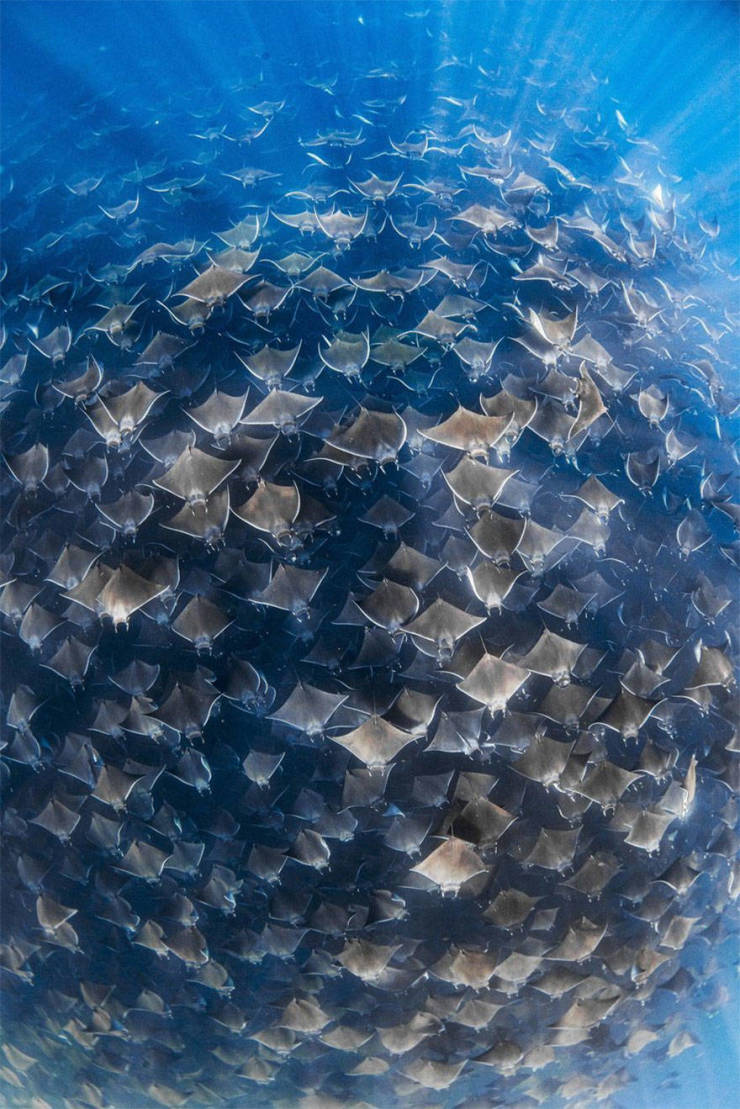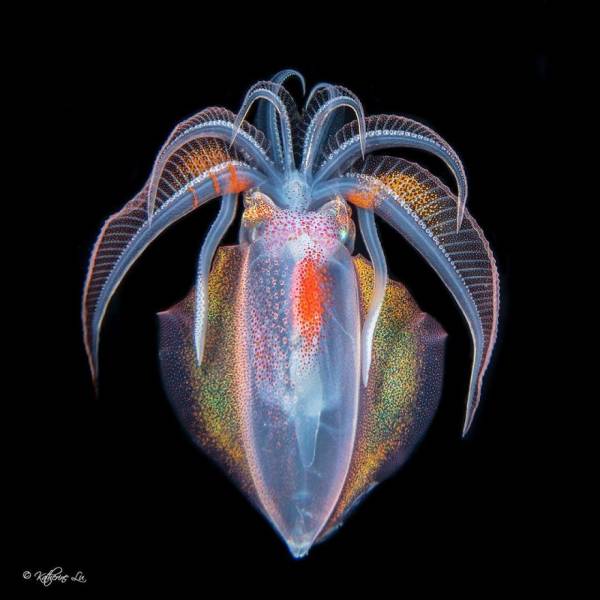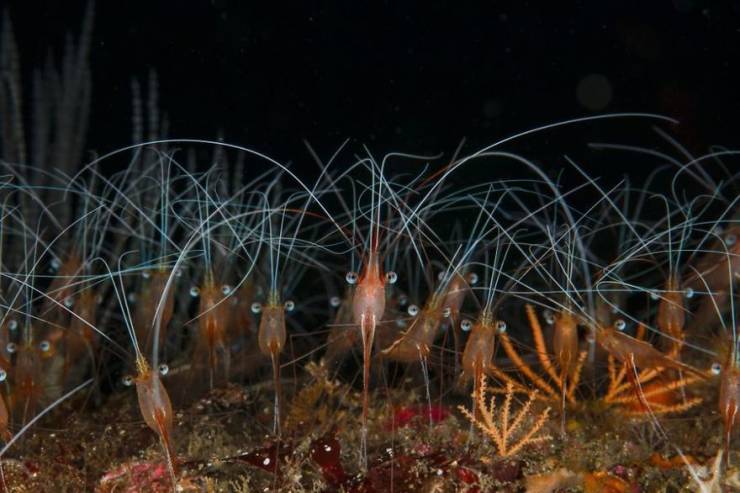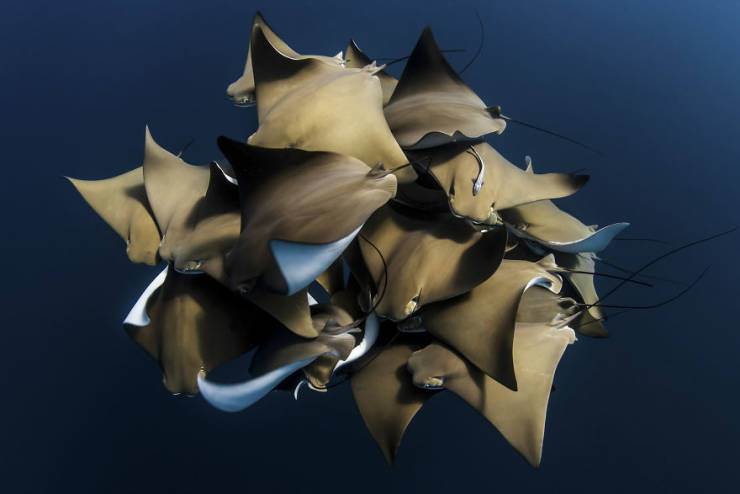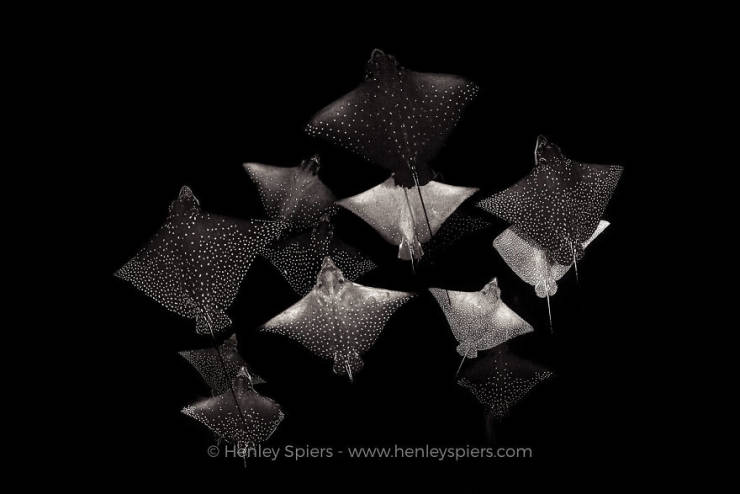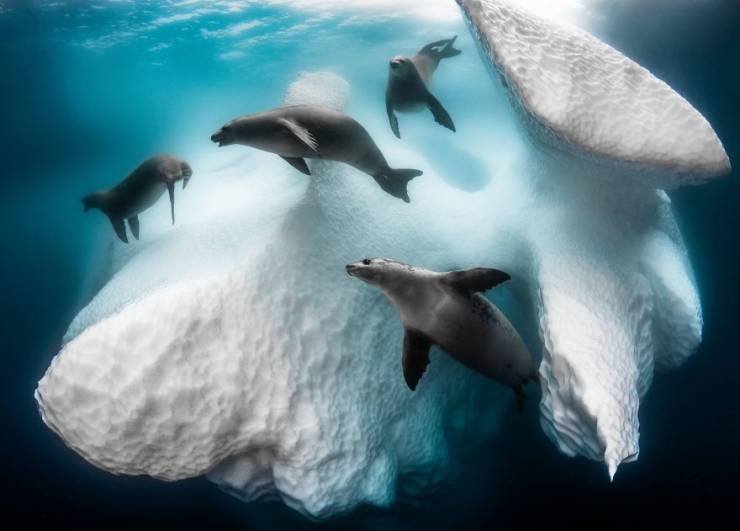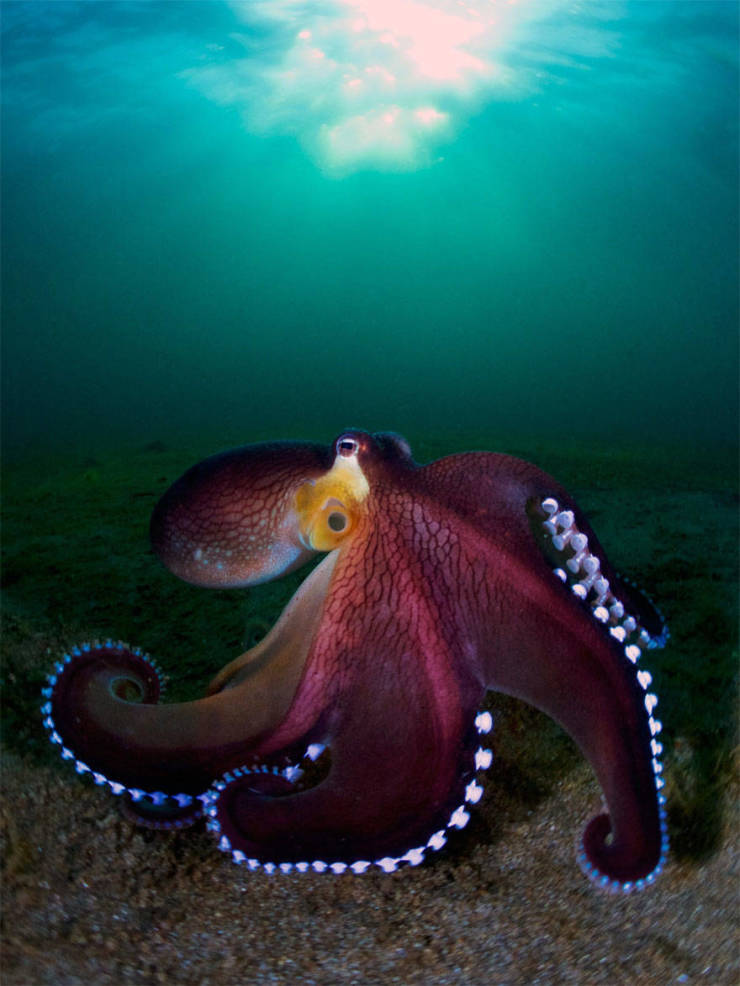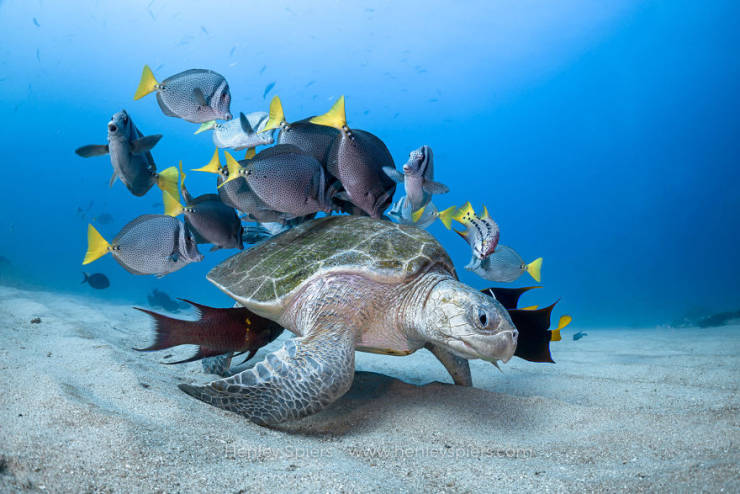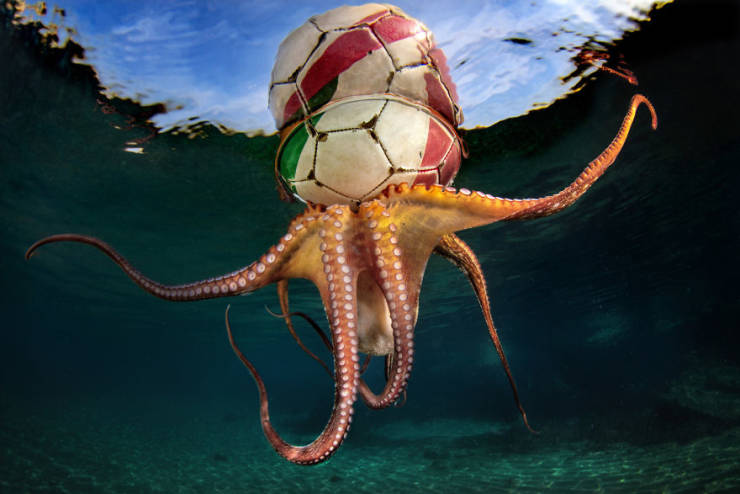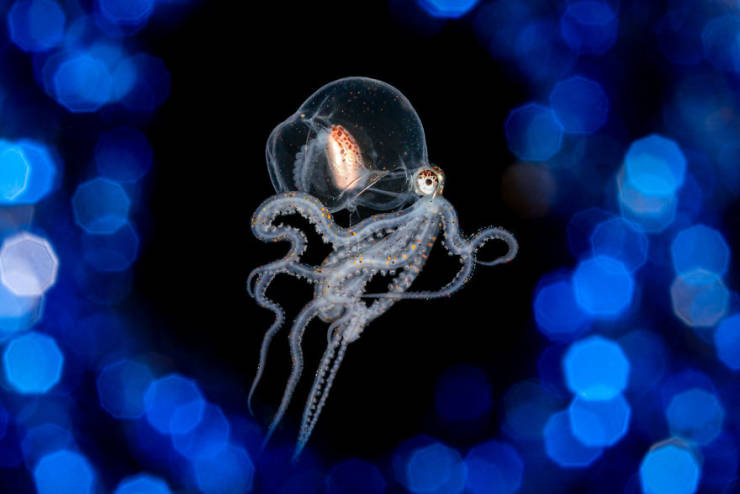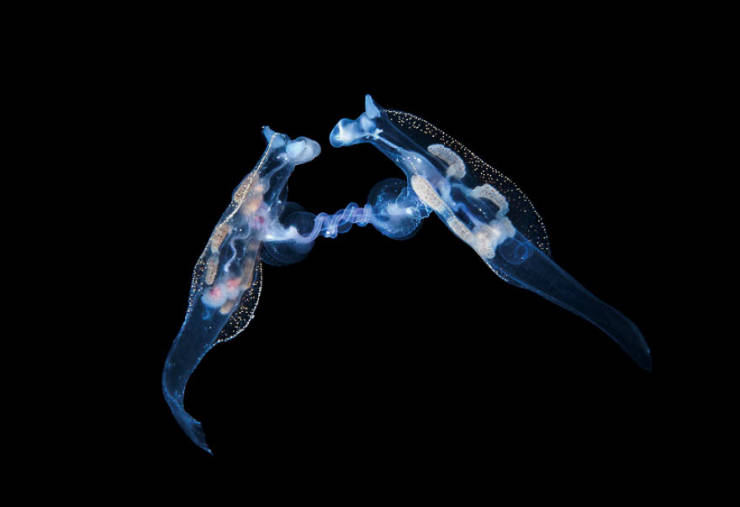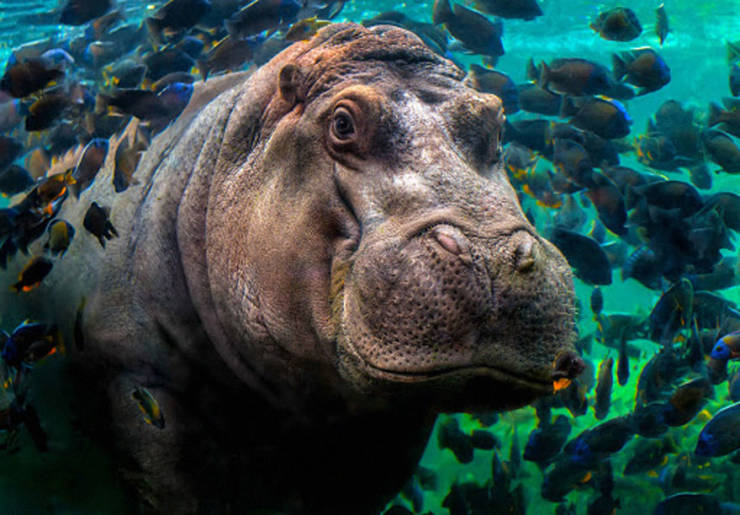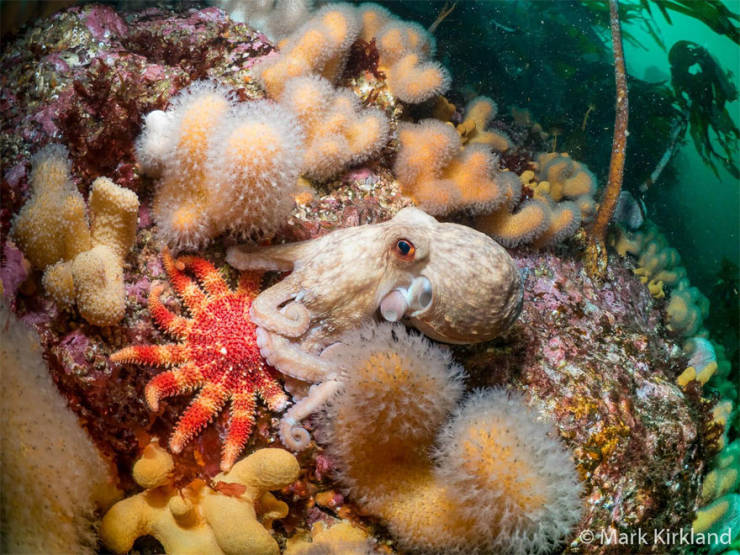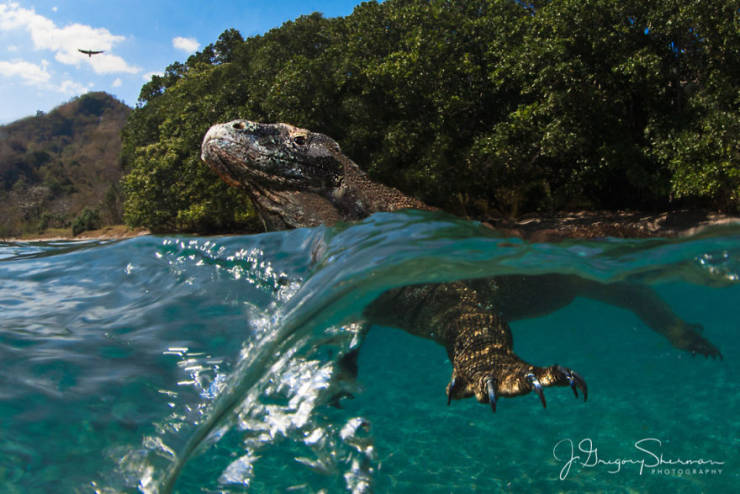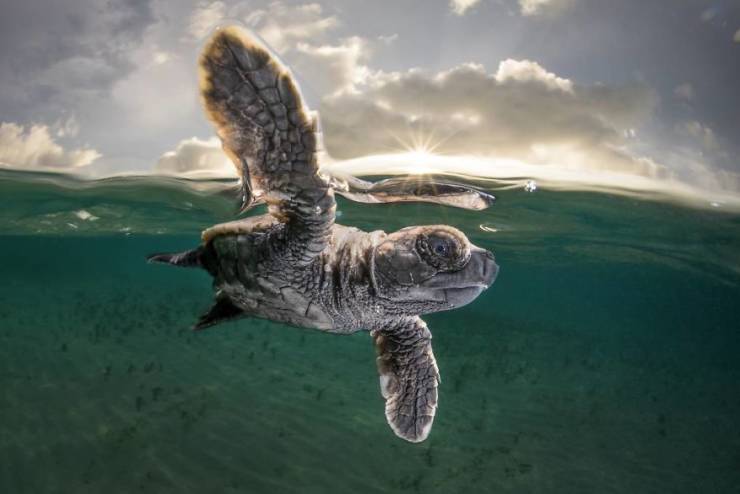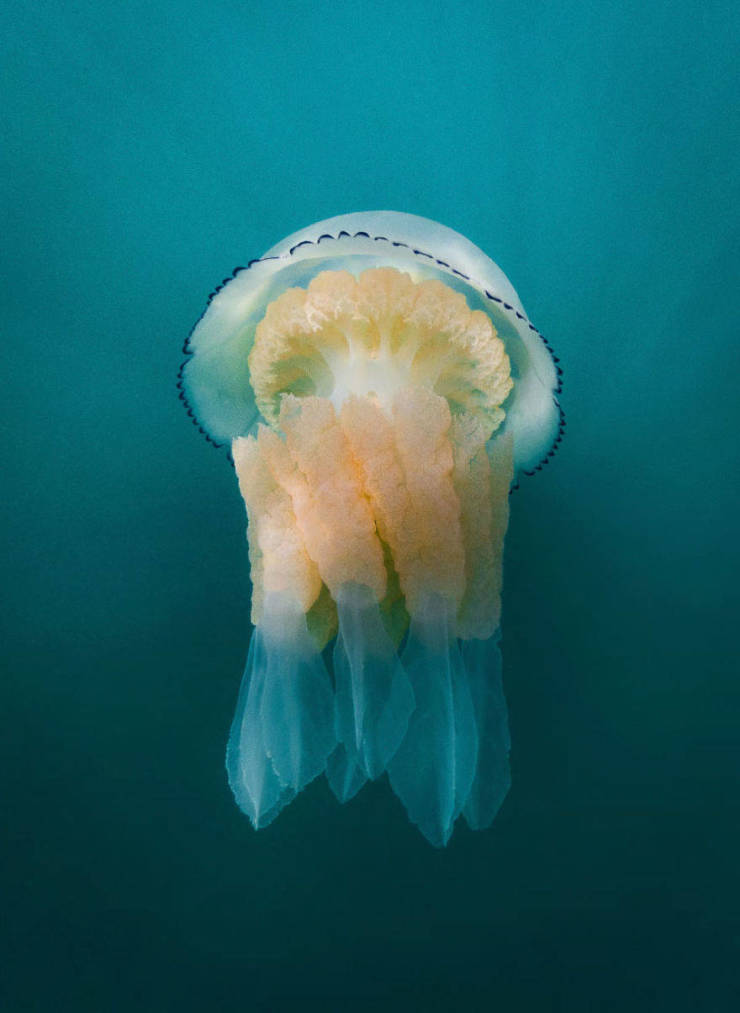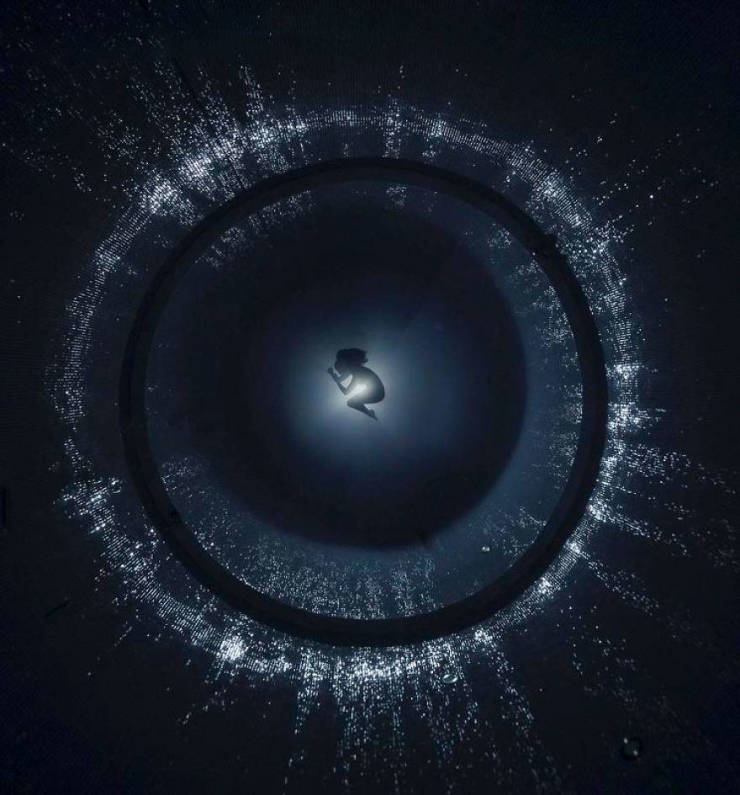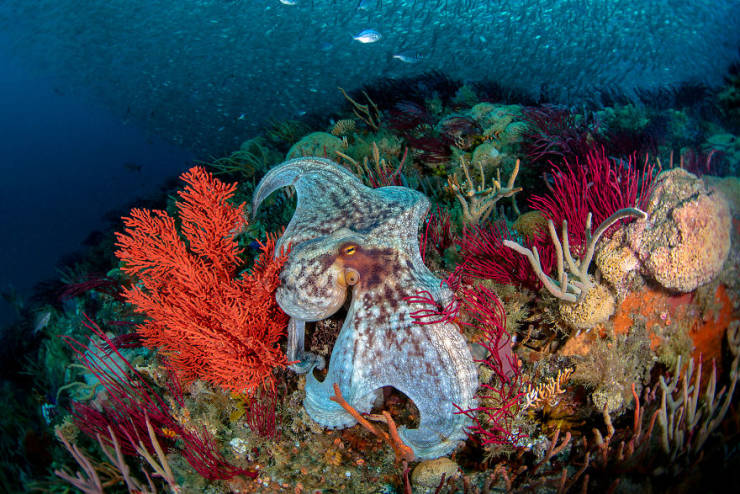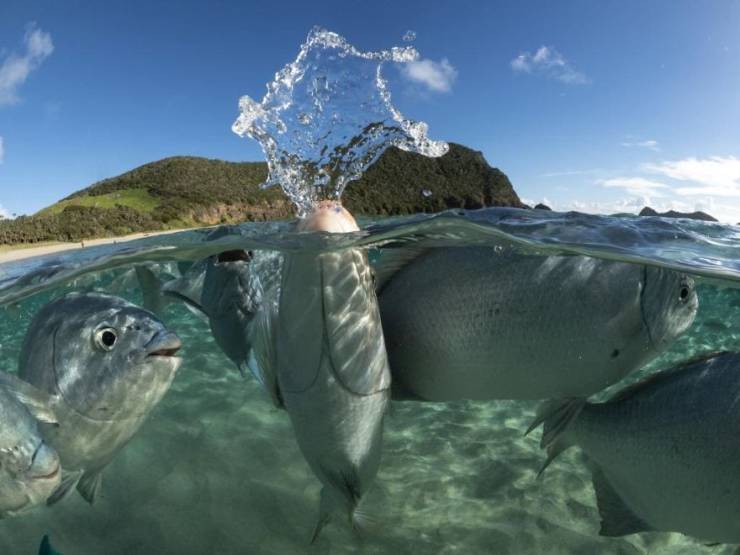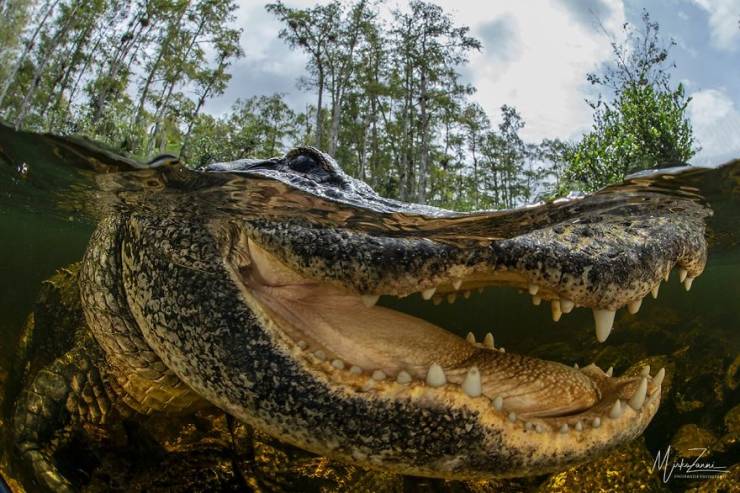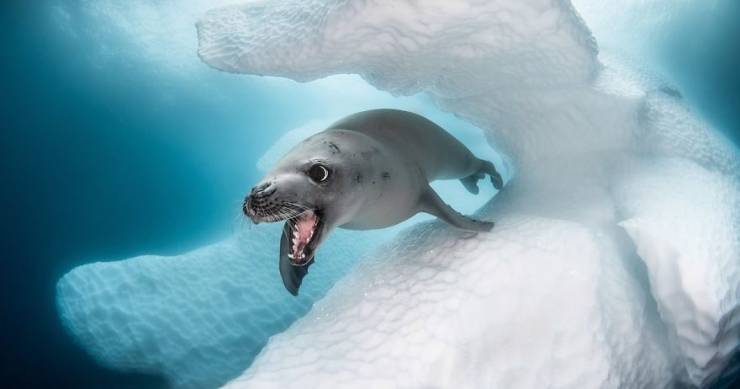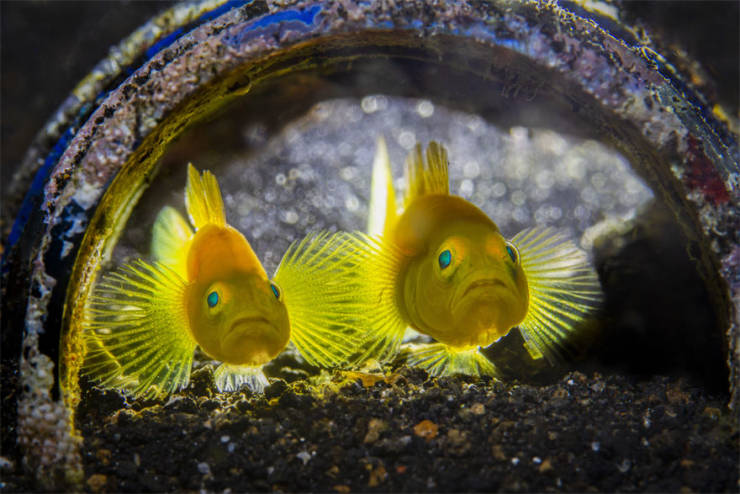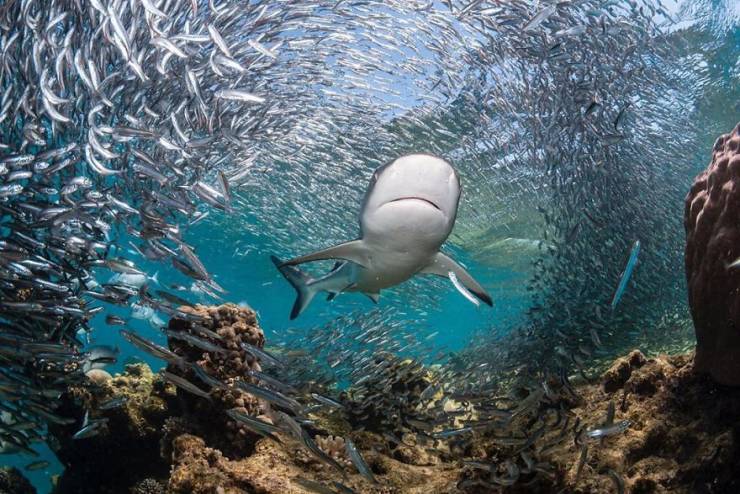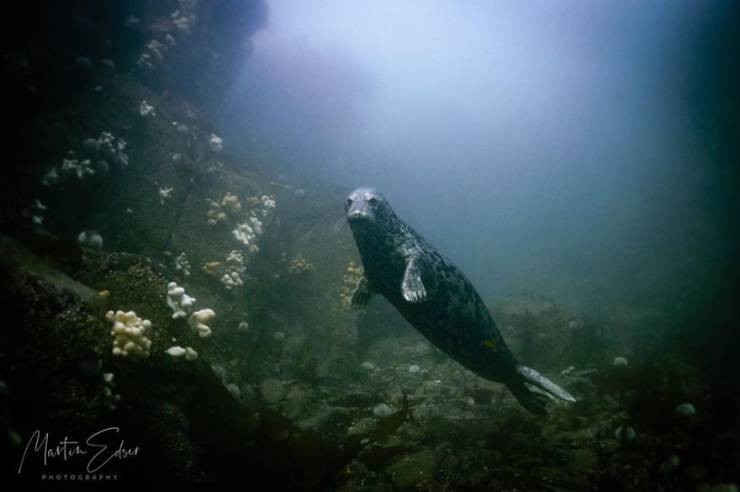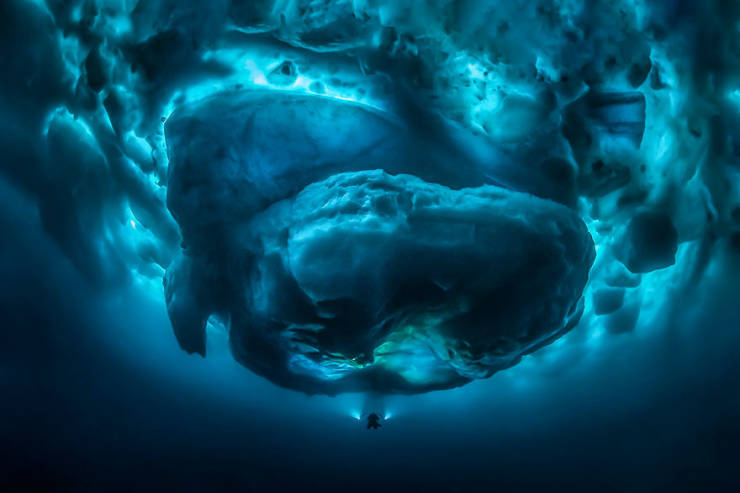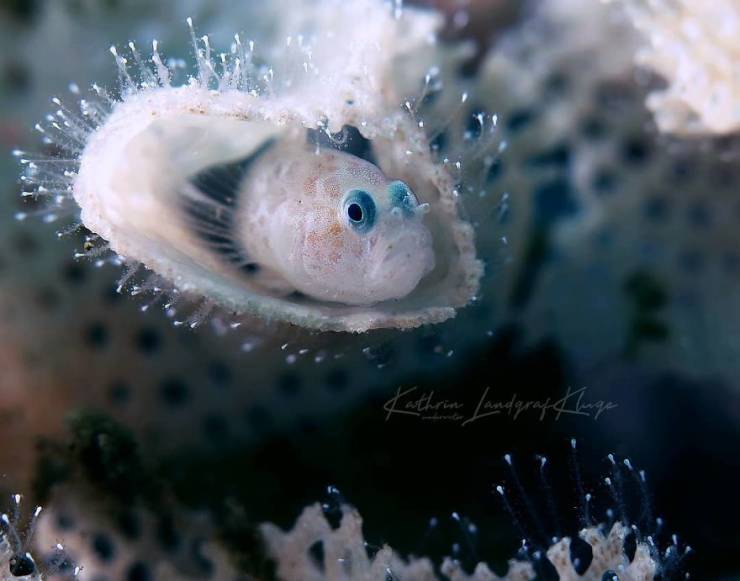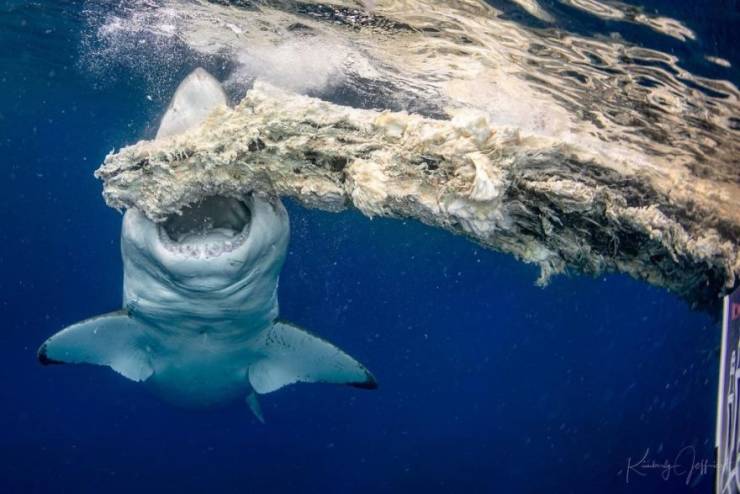#1 Behaviour Category: 'Together' By Nadia Aly, USA
I was very lucky to see this group of aggregating mobula rays off the coast of Baja, Mexico, on my annual expedition.
A truly lucky encounter with almost perfect visibility. This group was circling for what seemed like hours, ever so slowly and it felt like there could have been 10,000 or more of them.
#2 Macro Category: 'Dancing In The Dark' By Katherine Lu, USA
This shot was taken during my very first Blackwater dive trip in Anilao, in water over 200m deep. Every night the great vertical migration occurs in the ocean where creatures that live in the deep mesopelagic layers migrate up to the shallower epipelagic zone, returning to depth before dawn. I was very fortunate to have a rare encounter with the diamond squid also known as the rhomboid squid (Thysanoteuthis rhombus). This squid was not very large, and was perhaps a juvenile, but incredibly beautiful as it put on a show of lights and colours for me. While my encounter was very brief I was lucky enough to be able to capture this image before it disappeared into the darkness.
#3 Portrait Category: 'Angry Seahorse' By Rooman Luc, Belgium
In June I heard that there was a seahorse at a certain dive site in the Eastern Scheldt, at a depth of 12m. From then on, I went looking for the seahorse every week, and eventually found it in August. It was posing so nicely around a pipe that I had ample time to photograph it with the snoot. This gives the seahorse an angry look, but that is fortunately a mere appearance.
#4 Macro Category: 'Eyes' By Keigo Kawamura, Japan
The Unicorn shrimp usually inhabits around 200 to 300 m deep, but they rise to about 40m due to breeding behavior. There are thousands to tens of thousands of shrimps but there are only a few suitable places to shoot them. The direction and density of the tide may vary depending on the direction, strength, and brightness in the ocean. I went there many times because I could only stay for 15 minutes once a day. I was lucky to be able to find and shoot the ideal situation.
#5 Behaviour Category: 'A Fever Of Cownose Rays' By Alex Kydd, Australia
A rare encounter with a fever of cownose rays on the Ningaloo Reef, Western Australia. This was a once in a lifetime encounter with a species that is rarely documented in this region. We unexpectedly came across the rays whilst searching for whale sharks. The rays were spiralling up and down the water column from the surface to 20 meters for a brief moment until they disappeared into the deep. The images were taken whilst freediving to approximately 6 metres. The rays were circling and rubbing together in a behaviour that is still not clearly understood. It may have been possible mating or a social behaviour. The exact species of ray is still debated, it is either Rhinoptera javanica or Rhinoptera neglecta.
#6 Black & White Category: 'Constellation Of Eagle Rays' By Henley Spiers, UK
A school of uniquely patterned spotted eagle rays passes beneath me on an unforgettable dive in the Maldives. Like most divers, I have always found these rays to be especially spellbinding, but also highly elusive! This school passed beneath me towards the end of our dive and it was one of those rare moments of huge admiration, as well as immense inspiration. I could visualise the image I wanted and, whilst the rays glided effortlessly, I swam my heart out trying to keep up and unlock the desired camera angle. The rays continued forward and deeper, giving me just a few moments to capture this frame. Scientists have just recently confirmed that the spotting on each ray is a unique identifier, the equivalent of a human fingerprint. I love how black and white reinforces that uniqueness, keenly displaying the distinctive spotting, as well as the subtle shading differences between each individual.
#7 Wide Angle Category Winner: 'Frozen Mobile Home' By Greg Lecoeur, France
Massive and mysterious habitats, icebergs are dynamic kingdoms that support marine life. As they swing and rotate slowly through polar currents, icebergs fertilize the oceans by carrying nutrients from land that spark blooms of phytoplankton, fundamental to the carbon cycle. During an expedition in Antarctica Peninsula with filmmaker Florian Fisher and freediver Guillaume Nery, we explored and documented the hidden face of this iceberg where crab-eater seals have taken up residence on icebergs that drift at the whim of polar currents.
#8 Compact Category: 'Coconut Octopus' By Enrico Somogyi, Germany
On a sunny afternoon I dived on a sandy divesite in Sugar Beach. There I found a coconut octopus crawling on the sand.
When I got closer he started a nice pose for me and I got the shot.
#9 Behaviour Category: 'Turtle & Friends' By Henley Spiers, UK
A large olive ridley turtle rests peacefully on the sea bed as it is manicured by an eager group of reef fish. Turtle shells are often populated by epibionts, or tiny ocean hitchhikers, who use the shell as a home and a way of spreading their gene pool to new areas. They do not harm the turtle in small numbers, but should their presence grow too great, the turtle will be uncomfortably encumbered. To prevent this from happening, turtles have been known to recruit the services of fish, who feed on these epibionts in a mutually beneficial, symbiotic relationship. Even so, this behaviour is rarely witnessed by divers, and I was delighted to find this scene upon dropping in for a dive at Cabo Pulmo National Park, where strict marine protection measures have resulted in a safe haven for marine life.
#10 Behaviour Category Winner: 'Octopus Training' By Pasquale Vassallo, Italy
At the end of a session of free diving, I noticed a soccer ball, in the distance and on the surface. Intrigued I approached it, and then I noticed that below it was an octopus that was being pulled along by the current. I do not know what it was doing under the ball, but I think it is training for the next football World Cup! There was time for me to take a couple of shots before the octopus let go of the ball and dropped back to the seabed.
#11 Macro Category: 'Bling' By Lilian Koh, Singapore
It is a slow black water night in Anilao where there is not many subjects in sight and mostly not suitable to use this foreground bokeh technique. I was drifting along the current until this juvenile wunderpus octopus (wunderpus hotogenicus) came along at around 25m depth.
#12 Behaviour Category: 'Say Me' By Paolo Isgro, Italy
This photo was taken in Tonga during a Naia liveaboard. On the second day, in the middle of lunch, the cruise director called us because there was a lot of whale action right around the boat. So in a fraction we climb out of the chair, jump into the wetsuit swallowing the last bite and dive into the water. A couple of young whales really want to play with us and minutes after minute they get closer and closer. And it was during a freediving at 10 m that I saw this whale caming so close to me: it looks at me very intensely and says “Hello” in one breath exhaling so many bubbles.
#13 Behaviour Category: 'Mating Nudibranchs' By Steven Kovacs, USA
Traveling 5 miles off the coast of Florida at night and jumping into the ocean to drift near the surface in 600 foot depth, one can come across many wonderful and strange pelagic animals. One of these amazing animals is this pelagic Nudibranch (sea slug) that swims and lives up in the water column.
Just coming across these wonderful creatures is rewarding enough but on one particular dive I was fortunate to come across two of them together. It took a moment to realize that they were connected to each other and were, in fact, in the process of mating. What made this super rare encounter even more special is that in the split moment the photograph was taken, it appeared as if the nudibranchs were introducing themselves face to face with a handshake. A truly unique encounter in an other worldly setting.
#14 Portrait Category: 'Close Encounters' By Pedro Jarque Krebs, Peru
The hippopotamus is one of the most dangerous animals because of its strength and territoriality. Approaching a hippopotamus in its territory and underwater can be fatal...
Therefore, my photograph was taken with a hippo in captivity, which has ideal facilities with ample space for immersion, so that I could focus on what really interests me in myp hotography, namely to portray the animals as closely as possible.
I specialize in animal photography and in general my portraits are taken either in a natural environment or in captivity and even in sanctuaries. I try to establish a more intimate relationship between the animal and the viewer, and in general I isolate the animal from any context to avoid distractions. This photograph is one of the few animal portraits I have taken without a black background.
#15 British Waters Wide Angle Category: 'Octopus And The Sunstar' By Mark Kirkland, UK
This was my first ever encounter with an Octopus and it couldn’t have happened in a more beautiful underwater landscape. I was on the liveaboard MV Halton, exploring the crystal clear waters of the far north coast of Scotland when we dropped onto the reef walls of Eilean Nam Ron. The visability and abundance of life made wide-angle photography a dream. I kept my distance from this small curled octopus as it traversed the reef wall. It kept it’s gaze on me as I followed it before it eventually stopped and changed from bright orange to pale yellow to blend in with the surrounding soft corals. I took this as a hint that I was outstaying my welcome and took this last photograph before leaving it to it’s day.
#16 Wide Angle Category: 'Dragon Split' By J. Gregory Sherman, USA
While Komodo Dragons are primarily land reptiles, they will venture into the water if something warrants investigation.
For this image we went out in a RIB to take a look at the Dragons and I had brought along my rig “just in case”. One particular Dragon came out and repeatedly got VERY close including trying to climb on and into the RIB on several occasions. I suspect that he has become habituated to humans and was looking for a handout.
In hindsight I’m not sure it was the safest thing I have ever done so I’d have to add the caveat ‘Don’t try this at home!”
#17 Portrait Category: 'High Five - A Newly Hatched Hawksbill Turtle' By Matty Smith, Australia
I flew out to PNG specifically to shoot this image. Upon arrival I knew I would only get one chance to get it right, so I spent the day testing lens & lighting experiments on a small piece of driftwood about the same size as the turtle (4cm) to get my technique perfected before the real event. In the end I opted for a 4”port with the fisheye with 2 snooted strobes. One strobe above the water pointing down and the other underwater pointing up at the hatching. When my chance came to get this shot I had less than a minute to nail it, the extensive preparation paid off.
#18 British Waters Compact Category: 'They’re Back' By Colin Garrett, UK
The mighty Barrel Jellyfish to the best of my knowledge, had not been seen around Portland since the Summer of 2015. Myself and some diving friends had waited year after year for their return, as they make in our opinion beautiful subjects to photograph. Within the first few months of 2019 the wish became reality and I sighted my first of many. Snorkeling above this beautiful creature in clear blue water I snapped and snapped away taking seemingly endless photos. Reviewing them later, for me at least, one photo truly stood out... this one.
#19 Wide Angle Category: 'Her' By Jingle Guo & Fdb, China
I have wanted to take a photo like this since the first moment I went underwater. The unprecedented quiet and solitude, and the feeling of mother nature’s embrace is what being underwater emotes in me. The aim of this photo is to express this, a feeling of being in the universe, like a baby in mother’s womb, when we’re underwater. The photo was taken at a diving venue in FuZhou, China. I used back lighting, which when it touches the tiles on the wall, creates a beautiful effect.
#20 Wide Angle Category: 'Over The Reef' By Nadia Aly, USA
I had just descended and was getting myself sorted. I had not even turned my camera and strobes on, when I saw this octopus crawling over the reef. The visibility was superb, the guides said it was the best they had seen it in a while. I quickly turned my camera gear on and took a few shots, before this octopus started hunting and moving quickly between the corals.
#21 Behaviour Category: 'Emperor Among Drummers' By Scott Portelli, Australia
An Emperor fish tussles for position among a school of silver drummer fish in the shallows at Lord Howe Island, Australia, competing for prime position to devour any scraps left by tourists visiting to watch this behaviour. The Emperor fish spurts a stream of water out of its mouth in an attempt to distract the other fish from a potential free meal.
#22 Portrait Category: 'Close Encounters In The Swamps' By Mirko Zanni, Switzerland
During my last trip to Florida to photograph Goliath groupers, I had to change my travel plans due to hurricane Dorian ... so I went to visit the Everglades to be able to photograph the American alligator, it didn’t take long to find some alligators of considerable size and not at all afraid of my camera housing!
#23 Portrait Category: 'Crab-Eater Seal' By Greg Lecoeur, France
During an expedition on a small sailboat, Guillaume Nery, Florian Fisher and myself explored the Antarctica Peninsula by diving below the surface. Although the conditions were extreme with a temperature of -1° C, we documented extraordinary marine life in a fragile ecosystem, such as on this image: crab-eater seal. We also saw leopard seals, gentoo penguins, Antarctica fur seals, and Weddel seals. All these marine animals are affected by global warming with the melting of the ice. Despite the name, Crabeater Seals don’t eat Crabs. Krill make up to 95% of a Crabeater Seal's diet. Crabeater seals have developed a sieve-shaped tooth structure that filters krill, much like whale baleen. They suck up water containing krill, close their jaws, and push the water between their specialized teeth, trapping the krill inside.
#24 British Waters Living Together Category: 'Cone Home' By Kirsty Andrews, UK
It’s never nice to see discarded manmade items on the sea floor, but in this case, a common lobster (Homarus gammarus) was taking advantage of the situation. A traffic cone provided a handy vantage point to overlook the seabed as well as a large lobstersized shelter on an otherwise relatively flat landscape.
#25 Macro Category: 'Lemons' By Mika Saareila, Finland
I wanted to photograph a Lemon fish couple with backlight and bokeh balloons. The Dive into Lembeh dive guide found a suitable target and placed the light behind it, and I could take the picture I wanted :)
Background backscatter and backlighting did add nice bokeh balloons to the picture :)
#26 Up & Coming Category: 'Bait Ball Of Life' By Emilie Ledwidge, Australia
Ningaloo Reef is home to an array of unique marine animals, including numerous species of sharks such as this grey reef shark. When I found this bait ball I dove down, holding on to some rock to stay steady and motionless hoping that I would go unnoticed by the many sharks surrounding the reef bommie. As I held my breath, seeing nothing but a wall of tiny fish, I hoped that one of the sharks would go straight through and over my head and sure enough one did.
It is moments like these that I am forever grateful for sharks to exist. As the apex predators of the reef the grey reef sharks balance the ecosystem; feeding on the dying, weak, injured and slow fish so only the strongest survive. Without sharks, without healthy fish populations and without an ocean full of life who knows what the future looks life.
#27 British Waters Compact Category: 'Million Miles Away' By Martin Edser, UK
Diving with seals is always a privilege and I love the opportunity to photograph them. Like us they have different characters and moods. Trying to capture some of these traits in a photograph is what I have tried to accomplish this year on my visit to the Farne islands. Wide angle and ambient light is my preference. The water was clear enough here to take a picture at some distance and capture this seal in what seems to be a moment of far away contemplation. The lighting, haziness of the water and surrounding fauna help to give, I believe, an ethereal quality to the image adding to the ‘million miles away’ look. The reality is of course this seal is being very attentive of me and choosing to keep its distance!
#28 Wide Angle Category: 'Sub Zero' By Tobias Friedrich, Germany
During an expedition in East Greenland under the ice, one diver took his video lights with him to swim underneath the iceberg. The water was minus 2 degrees with outside winds up to minus 27 degree Celsius, in which we sometimes only could do one dive per day. The whole fjord was frozen with the icebergs frozen into the surface. We had to get our gear on a snowmobile and man-powered sledge every day to an iceberg we thought could be nice and made some holes around it. Only in the water could we see the real dimensions of the whole iceberg.
#29 Compact Category: 'In My Place' By Kathrin Landgraf-Kluge, Germany
I fell in love with the super tiny underwater critters only recently, less than 3 years ago during a holiday to Lembeh. I soon returned with my compact camera equipment upgraded for super macro photography by adding a 15+ macro lens. It was during one of my first dives with the new equipment when I took this photo. We spotted this tiny Bryozoan Goby and I really loved how he looked like peeking out from a window of his home. I was lucky to get the shot like this! I only learned later that this species was only discovered 7 years ago and that this one is on the list of many photographers which makes the photo even more special for me!
#30 Behaviour Category: 'Great White Bite' By Kimberly Jeffries, USA
For several days we visited the resting site of a deceased sperm whale hoping to capture the natural events that unfolded. We were treated to visitations from some of the most beautiful and threatened species in the world and witnessed incredible and natural feeding events. One of the most memorable visitors was this newly identified white shark. The behavior of each shark was unique not just to the species but to individual and their reactions to various divers all very different. It was thrilling to document and witness these creatures, knowing that these images would go on to help scientists put together new knowledge and understanding to help protect our oceans.

